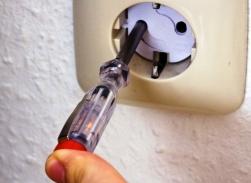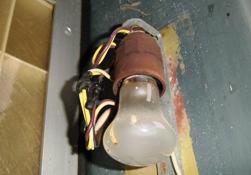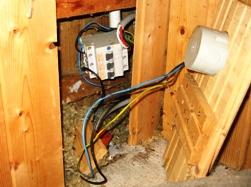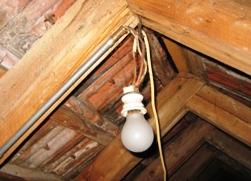Categories: Featured Articles » Electrician at home
Number of views: 84910
Comments on the article: 4
Wiring malfunctions: why are they dangerous, and how to prevent them?
 Electricity is a source of energy, and benefits until it gets out of control. Having escaped to freedom, it can create many troubles, the main of which is a fire.
Electricity is a source of energy, and benefits until it gets out of control. Having escaped to freedom, it can create many troubles, the main of which is a fire.
The main cause of fire hazard situations is, of course, faulty wiring. It is necessary to monitor the state of insulation of wires and cables, in time to replace damaged ones. Also a big danger in the fire plan is the old wiring, made "under King Gorokh." Over time, the insulation of such wires simply dries up, cracks and crumbles, which can lead to a short circuit and fire in the premises.
The old wiring was carried out by wires, the insulation quality of which was much lower than that of modern ones. It is worth remembering at least the cords of old electrical appliances in thread insulation or external open wiring on ceramic rollers.
 The reason for the increased fire hazard may be an insufficient cross-section of conductive conductors. A wire with a cross-sectional area of conductivity 0.75 mm2 is quite sufficient to connect a light bulb or even a chandelier. But if you connect a modern washing machine, iron or kettle to such a wire, it will heat up very much, which will lead to melting of the insulation, and then to a short circuit. Strictly speaking, the cross-section of conductors is selected from the estimated load, either by calculation or using ready-made tables at the design stage of the wiring.
The reason for the increased fire hazard may be an insufficient cross-section of conductive conductors. A wire with a cross-sectional area of conductivity 0.75 mm2 is quite sufficient to connect a light bulb or even a chandelier. But if you connect a modern washing machine, iron or kettle to such a wire, it will heat up very much, which will lead to melting of the insulation, and then to a short circuit. Strictly speaking, the cross-section of conductors is selected from the estimated load, either by calculation or using ready-made tables at the design stage of the wiring.
Electricity leak
Damage to the insulation of the wires can lead to a malfunction such as leakage. This is the probability that, under certain conditions, part of the energy may not go where it should. A simple example. Wires are laid under the plaster.
When dry, it is an excellent insulator, so damage to the insulation of TPG is not detected in any way. But if under some conditions the plaster becomes wet, for example, heating or plumbing has leaked, it immediately becomes conductive, not even a source of electricity. If a person comes in contact with such a wall, it is possible to cause an electric shock.
Short circuit and its causes
It is known that faulty wiring leads to a short circuit, it most often causes a fire from it. This is often mentioned in fire reports. What is a short circuit, why is it dangerous?
 In normal operation, the current in the wiring between the phase and neutral wires flows through the load, which limits this current to a level safe for wiring. When the insulation is destroyed, the current flows, bypassing the load, immediately between the wires. This contact is called short, because it occurs in addition to the electrical appliance.
In normal operation, the current in the wiring between the phase and neutral wires flows through the load, which limits this current to a level safe for wiring. When the insulation is destroyed, the current flows, bypassing the load, immediately between the wires. This contact is called short, because it occurs in addition to the electrical appliance.
Recall Ohm's law: I = U / R, which, in words, is usually pronounced like this: "The current in the circuit is directly proportional to voltage, and inversely proportional to RESISTANCE." It is on RESISTANCE here that it is worth paying attention.
The resistance of the conductors of electrical conductors, as a rule, is small, so they can be neglected, considered it equal to zero. According to the laws of mathematics, division by zero is impossible, and the result will tend to infinity. In the case of a short circuit, the current in the circuit will tend to this same infinity.
Of course, this is not entirely true, the wires have some kind of finite resistance, so the current will not reach infinity, of course, but there will be enough strength to produce a destructive effect, a sufficiently powerful explosion. A voltaic arc arises, the temperature of which reaches 5000 degrees Celsius.
In this sense, the closure of two phases in an industrial three-phase network is very indicative: if the wires were "shortened" simply by a screwdriver, only a pen will remain from it, and the unlucky electrician can be thrown back several meters, cause burns and even shell shock.
At home, in a single-phase network, such a powerful firework cannot be arranged, but, nevertheless, the consequences can turn out to be quite impressive. The molten wires will burn the insulation, fly in different directions sparks, splashes of hot metal. If flammable objects are nearby, wait for the fire. Therefore, the worst thing that can happen in wiring is a short circuit.
Causes of a short circuit and how to deal with them
 All faults in electrical circuits can be divided into two large groups: this is the lack of contact where it is needed, and the presence of one where it is not needed. So a short circuit, according to this almost comic classification, refers to the second part of the phrase. Where does this unnecessary contact come from, what are the reasons for its occurrence, and what should be done to prevent it from arising?
All faults in electrical circuits can be divided into two large groups: this is the lack of contact where it is needed, and the presence of one where it is not needed. So a short circuit, according to this almost comic classification, refers to the second part of the phrase. Where does this unnecessary contact come from, what are the reasons for its occurrence, and what should be done to prevent it from arising?
There are several causes of a short circuit, and they are quite simple. This is a poor insulation quality, improper wiring, poor contact in the wiring connections and electrical appliances. Methods of dealing with these negative phenomena are quite simple, there are not so many of them, and they should be carried out both in the process of installing a new one and in the operation of an existing wiring. These activities are:
It is important not to allow the use of old cables with damaged insulation, to replace them in time.
Before drilling or chiselling the walls, it is necessary to check whether the wiring in this place passes. For this purpose are now sold hidden wiring seekersThere are also quite a lot of simple amateur constructions.
Before performing work with wiring it must be de-energized. The truth, it seems, is common, but not all and not always, unfortunately, follow it.
 To prevent short circuits, protective devices must be installed in the network. In the simplest case, these are fuses - plugs, and according to modern requirements, these are circuit breakers, RCD and differential automata.
To prevent short circuits, protective devices must be installed in the network. In the simplest case, these are fuses - plugs, and according to modern requirements, these are circuit breakers, RCD and differential automata.
Outdated sockets and switches, sparking during operation, should be replaced in a timely manner with new ones: from constant sparking, it is possible to destroy the insulation, and then everything that has already been described above. Timely replace switches and sockets with cracked cases and traces of soot.
Do not use faulty electrical appliances that spark during operation. In this sense, the exception is vacuum cleaners, drills, rotary hammers and even coffee grinders. In general, all appliances that use a carbon brush motor. It is these brushes that should spark during operation, this is normal.
When installing the wiring, if possible, do not place it too closely, twist them in a bundle. This can lead to insulation damage already during installation.
These simple recommendations will help to avoid a short circuit, and as a result, a fire.
We recommend reading:Wiring problems: what to do and how to fix them?
See also at bgv.electricianexp.com
:
